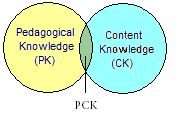When writing a professional development course based on a TPACK framework, you should be able to work with TPACK yourself. When working with TPACK I first had to learn what TPACK was. During a course on University Twente I first heard about the TPACK model.
At first I wasn’t sure how this model would work, but when I got to know the model I saw that it was a nice and practical model, I got convinced. The part I like most is that the model itself is based upon a model that teachers (and I) can relate to.
During the development of the professional development course we had to integrate TPACK as well. Not only on how to teach it, but also during the course itself. So we had to make sure that our course itself was TPACK. This wasn’t as easy as I first thought, an important part why I found this difficult is that I didn’t know all the possibilities of the different technologies. I know that it is impossible to keep up with all of them, but still I felt like a novice. Although I already saw a lot of examples during lectures, I still found it difficult to not only use a technology, but to use it in a way that it would enhances the course.
So the actual integration part was indeed the difficult part. I realized that it was easy to add technology, but integrating was a different story. But I think we did succeeded in this part, during the course we made sure that the instructors used technology as well. The variety could be larger, but I think that experience also plays a part in this aspect. The more experienced you become in integrating technology, the more different possibilities you'll get to know.
But I do think that it is important to start working with TPACK, for teachers but also for educational designer. In the future I will be an educational designer, so if I expect teachers to start integrating technology in their teaching, I should give an example by integrating it as well. To do this probably, I think I need extra practice.
During the a lecture I did TPACK survey to measure my TPACK, if the course is over I will complete the survey again. I am curious if my TPACK will have gone up.
How to stimulate teachers on integrating technology:
At this moment a lot of teachers use technology in their teaching, but they only use technology as a replacement in stead of an enhancement in teaching. I think a lot of teachers find it difficult and time consuming to figure out how technology can help them and increase learning outcomes of their pupils.
- I think a way to stimulate teachers is to show how important it is to keep up with society. I think that teachers already see that a lot of pupils know how to use different kinds of technology. Probably more kinds of technologies than the teachers know themselves. By showing the teachers that it is important to keep up with these developments, might change the attitude of teachers. But I don’t think that only this method will be enough to stimulate teachers.
- It could be combined with showing the different possibilities. This is another way to stimulate teachers on integrating technology. By showing the different possibilities you can create positive attitudes. I also think that it helps because teachers see people that have been in the same position as themselves and therefore can relate with them. The teachers can tell each other how they overcame difficulties and the teachers that haven’t started integrating technology can ask questions and talk about their uncertainties.
- These are possibilities for teachers that are already teaching, but are also possible for pre-service teachers. If you integrate this in the subjects given during teacher training, you make sure that the new generation integrates technology as well.
All if this indicates that there is still a lot of work to do for educational designers and teachers!




